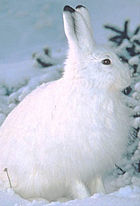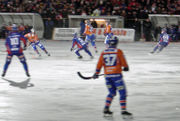Winter
2008/9 Schools Wikipedia Selection. Related subjects: Climate and the Weather; Everyday life
Winter is one of the four seasons of temperate zones. North American calendars go by astronomy and state that winter begins on the winter solstice and ends on the vernal equinox. Calculated meteorologically, it begins and ends earlier (typically at the start of the month with the equinox or solstice) and is the season with the shortest days and the lowest temperatures. Either way, it generally has cold weather and, especially in the higher latitudes or altitudes, snow and ice. The coldest average temperatures of the season are typically experienced in January in the Northern Hemisphere and in July in the Southern Hemisphere.
Aspects
Meteorology
Meteorological winter is the season having the shortest days and the lowest temperatures. Nighttime predominates the winter season, and in some regions it has the highest rate of precipitation as well as prolonged dampness because of permanent snow cover or high precipitation rates coupled with low temperatures, precluding evaporation. Blizzards often develop and cause many transportation delays. A rare meteorological phenomenon encountered during winter is ice fog, which is composed of ice crystals suspended in the air and happening only at very low temperatures, below about −30 °C .
Period
It is often said that, astronomically, winter starts with the winter solstice and ends with the vernal equinox. In meteorology, it is by convention counted instead as the whole months of June, July and August in the Southern Hemisphere and December, January and February in the Northern Hemisphere. While in actuality, the most accurate start and end point is simply defined by when the first major wave of cold fronts and warm fronts hit a particular area, having no universally predetermined dates.
In Celtic countries such as Ireland using the Irish calendar, the winter solstice is traditionally considered as midwinter, with the winter season beginning November 1 on All Hallows or Samhain. Winter ends and spring begins on Imbolc or Candlemas, which is February 1 or February 2. This system of seasons is based on the length of days exclusively. The three-month period of the shortest days and weakest solar radiation occurs during November, December and January in the Northern Hemisphere and May-July in the Southern Hemisphere.
Also many mainland European countries tend to recognize Martinmas, St. Martins day ( November 11) as the first calendar day of winter. The day falls at midpoint between the old Julian equinox and solstice dates. Also, Valentines Day ( February 14) is recognized by some countries as heralding the first rites of spring, such as flower blooming.
In Chinese astronomy (and other East Asian calendars), winter is taken to commence on or around November 7, with the Jiéqì known as (立冬 lì dōng, literally "establishment of winter".)
The three-month period associated with the coldest average temperatures typically begins somewhere in late November or early December in the Northern Hemisphere. If "winter" is defined as the statistically coldest quarter of the year, then the astronomical definition is too late by almost all local climate standards, and the traditional English/Irish definition of November 1 ( May 1 in the Southern Hemisphere) is usually too early to fit this standard. No matter the reckoning, winter is the only season that spans two calendar years in the northern hemisphere. (In other words, there are very few temperate climates in which the vernal equinox is on average colder than the winter solstice, and very few temperate climates in which Samhain is colder than Imbolc).
Causes
The tilt of the Earth's axis relative to its orbital plane has a dramatic effect on the weather. The Earth is tilted at an angle of 23.44° to the plane of its orbit, and this causes different latitudes on the Earth to directly face the Sun as the Earth moves through its orbit. It is this variation that primarily brings about the seasons. When it is winter in the Northern Hemisphere, the Southern Hemisphere faces the Sun more directly and thus experiences warmer temperatures than the Northern Hemisphere. Conversely, winter in the Southern Hemisphere occurs when the Northern hemisphere is tilted more toward the Sun. From the perspective of an observer on the Earth, the winter Sun has a lower maximum altitude in the sky than the summer Sun.
During winter in either hemisphere, the lower altitude of the Sun in winter causes the sunlight to hit that hemisphere at an oblique angle. In regions experiencing winter, the same amount of solar radiation is spread out over a larger area. This effect is compounded by the larger distance that the light must travel through the atmosphere, allowing the atmosphere to dissipate more heat.
Exceptional cases
- Year Without a Summer was the name for 1816, because the weather was so cold that it reminded people of winter all year.
- In Europe, the winters of 1947, 1962-63 and 1981-82 were considered abnormally cold.
- The Winter of Discontent is the name for the British winter of 1978-79, during which there were widespread strikes. Lorry drivers, train drivers, nurses, most public sector employees, refuse collectors, and workers at Ford Motors all went on strike. Most notorious however was an unofficial strike by the gravediggers.
Ecology
To survive the harshness of winter, many animals have developed different behavioural and morphological adaptations:
- Migration is a common effect of winter upon animals, notably birds. However the majority of birds do not migrate, the cardinal for example. Some butterflies also migrate seasonally.
- Hibernation is a state of reduced metabolic activity during the winter. Some animals "sleep" during winter and only come out as warm weather returns. For example, gophers, bears, frogs, snakes and bats hibernate.
- Some animals store food for the winter and live upon it instead of hibernating completely. This is the case of squirrels, beavers, skunks, badgers and raccoons.
- Resistance is observed when an animal endures winter but changes in ways such as colour and musculature. The colour of the fur or plumage are changed to white in order to be confused with snow and thus, to retain their cryptic coloration year round. Examples are the ptarmigan, the arctic fox, the weasel, the white-tailed jack rabbit or the mountain hare.
- Some fur-coated mammals grow a heavier fur coat during the winter. This improves the heat-retention qualities of the fur. The coat is then shed following the winter season to allow better cooling. The heavier winter coat made this season a favorite for trappers who sought more profitable skins.
- Snow also affects the ways animals behave; many take advantage of the insulating properties of snow by burrowing in it. Mice and voles typically live under the snow layer.
Annual plants never survive the winter. As for perennial plants, many small ones profit from the insulating effects of snow by being buried in it. Larger plants, particularly deciduous trees, usually let their upper part go dormant, but their roots are still protected by the snow layer. Few plants bloom in the winter, though exceptions include the flowering plum (which flowers in time for Chinese New Year).
Activities
Snow activities
Many winter activities involve the use of snow in some form (which sometimes may still be manmade, via snow cannons):
- Bobsledding - a winter sport in which teams make timed runs down narrow, twisting, banked purpose-built iced tracks in a gravity-powered, steerable sled.
- Skiing - the activity of gliding over snow using fibreglass planks called skis that are strapped to the skiers' feet with ski bindings.
- Sledding - a downhill activity using a sled to glide downhill.
- Snowball fight - a physical game in which snowballs are thrown with the intention of hitting someone else.
- Snowboarding - an increasingly common sport where participants strap a composite board to their feet and slide down a snow-covered mountain.
- Snowshoeing - a means of travel on top of the snow by increasing the surface area of the feet.
- Snowman building - creating a man-like model out of snow.
- Snow castle building - for example constructions such as the SnowCastle of Kemi, the largest in the world.
Ice activities
Many other winter activities and sports focus on ice, which may be contained in an [ice rink]].
- Ice skating - a means of traveling on ice with skates, narrow (and sometimes parabolic) blade-like devices molded into special boots.
- Ice boating - a means of travel in a specialized boat similar in appearance to a sailboat but fitted with skis or runners (skates) and designed to run over ice instead of (liquid) water.
- Ice biking - The continuation of regular cycling activities in the winter and cold weather.
- Ice fishing - the sport of catching fish with lines and hooks through an opening in the ice on a frozen body of water.
- Ice diving - a type of penetration diving where the dive takes place under ice.
- Ice sculpture - elaborate sculptures are carved out of blocks of ice.
- Ice Hockey - A team sport played on the ice with skates, sticks and a puck. The goal is to send the puck in the adversary team's net.
- Curling - A team sport using brooms and stones. The object of the game is to slide your stones in a bullseye and get your opponent's stones out of it.
- Ice climbing - The recreational activity of climbing ice formations such as icefalls and frozen waterfalls.
Psychology

Passing seasons change the habits and moods of people. During the winter months in the northern hemisphere, a gloominess nicknamed "winter blues", "February blahs", "Holiday depression", or doldrums, is informally noted amongst people. The severest cases of this type of depression is diagnosed as seasonal affective disorder (SAD). Symptoms include sleeping more, tiredness, depression, and physical aches. Although causes include genetic disposition and stress, the prevailing environmental influence is decreased exposure to light because of the angle of the sun and cloudcover and the increased amount of clothing that must be worn to keep warm.
Symbolism
Some use winter to suggest death, as in Robert Frost's " Stopping by Woods on a Snowy Evening". Some use it to suggest the absence of hope, as in C. S. Lewis's The Lion, the Witch and the Wardrobe, where it was always winter but never Christmas. Winter is one concerto in Antonio Vivaldi's "The Four Seasons"; and there are many examples of four paintings, all showing the same scene in different seasons. Ursula K. LeGuin's novel The Left Hand of Darkness is set on a planet named Winter. In Alex Raymond's comic strip, Flash Gordon, there is a land called Frigia, where it is always winter. The land of Frigia is also featured in the serial Flash Gordon Conquers the Universe. Other uses of winter in the graphic arts occur in Winsor McCay's Little Nemo in Slumberland. There are many films in which a winter setting plays an important role, Fargo being an example. Novels such as Ethan Frome also use a winter setting to mirror the bleak, frozen feelings that the characters harbour. The film Requiem for a Dream concludes with "Act III: Winter", in which the movie reaches its hellish and chilling climax.
Mythology
In various cultures
In Greek mythology, Hades kidnapped Persephone to be his wife. Zeus ordered Hades to return her to Demeter, the goddess of the earth and her mother. However, Hades tricked Persephone into eating the food of the dead so Zeus decreed Persephone would spend six months with Demeter and six months with Hades. During the time when her daughter is with Hades, Demeter becomes depressed and causes winter. In Welsh Mythology, Gwyn ap Nudd abducted a maiden named Creiddylad. On May Day her lover Gwythr ap Greidawl fought Gwyn to win her back. The battle between them represented the contest between summer and winter.
Personifications
- Old Man Winter
- Father Winter
- Jack Frost
- Ded Moroz
- Snegurochka



